Sheep Diseases
Blowfly Strike
Also known as: Myiasis, Fly Strike
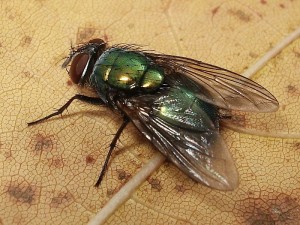
The adult Lucilia sericata are usually a metallic green and can also have a copper green color. The mouth parts are usually yellow. It is 10–14 mm long (from www.carnivoraforum.com)
Blowfly strike, or myiasis, is an important cause of sheep loss in a number of countries across the world, and in particular in the United Kingdom, Australia, New Zealand, Ireland and South Africa. It is common for 1-3% of sheep in a flock to be affected by fly strike (Broughan and Wall, 2006). It is a costly disease of significant welfare concern (Wall and Lovatt, 2015). Fly strike is usually visible as a discolored, moist area of wool which, on closer examination, reveals maggots and is foul-smelling. Affected animals are restless, dull and reluctant to graze, and kick at the struck area. Rapid diagnosis and treatment is essential. If untreated, strike will rapidly deteriorate causing an increased respiratory and heart rate, ammonia toxicity, coma and death.
The condition is caused by the invasion of living tissue by the larvae of dipteran flies. These flies can also reproduce in the absence of living matter. The females can lay over 1000 eggs, and under favorable conditions the life cycle may be completed in 7 days. Blowfly strikes usually occur in waves, with the odor from the first strike attracting other flies.
There are several species of fly that can commonly parasitise sheep (Morris and Titchener, 1997), and these can be characterized as primary and secondary flies. Primary flies (Lucilia sericata (green bottles) lay eggs on soiled areas of fleece or wounds. The larvae lacerate the skin using their anterior hooks and begin to digest tissue by secreting proteolytic enzymes. Secondary flies such as Lucilia Caesar, Protophormia terraenovae (black blowfly), and Calliphora erythrocephala (bluebottle) are unable to initiate strike themselves but are attracted to the damage already done. Secondary bacterial infection often occurs and the animal may die of septicemia or the absorption of toxins from liquified body proteins.
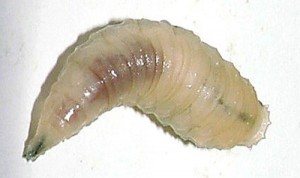
The larvae are white or yellowish through their development and reach a maximum of 12–18 mm before pupation (from www.carnivoraforum.com).
Influential Factors
There are two main factors that affect the onset of fly strike (Fenton et al., 1998):
1. the prevalence of the flies; and
2. the susceptibility of the sheep.
Climate is a critical risk factor and climate warming is likely to increase the risk of fly strike incidence (Wall et al., 2011). In the UK, the population of flies increases dramatically from late spring into mid-summer (French et al., 1995). Higher mean temperature and rainfall are risks factors (Broughan and Wall., 2007) and attacks are associated with hot and humid weather. Climate models and forecasts may be used to provide farmers with advance warning, but they are very dependent on the accuracy of weather projections. They indicate expected average patterns of strike incidence and may not therefore be appropriate for individual farmers whose husbandry practices differ substantially from the average (Wall et al., 2002).
In hill sheep, unshorn sheep are attacked in the early part of the season, with a second wave occurring in August and September. In lowland flocks, shearing is carried out earlier, and the first cases usually occur in July, often in lambs. There is some evidence to show ewes and ewe lambs are more susceptible than rams and male lambs (Snoep et al., 2002). Some breeds are more susceptible than others (see section below).
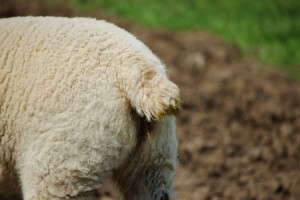 The struck area is usually soiled or damaged in some way to attract flies. Shorn sheep and young lambs with short fleeces are not usually attacked, but as the length of the fleece increases so does the risk of strike (French et al., 1996).The area around the tail or the breech is the most commonly infested area (Snoep et al., 2002; Broughan and Wall., 2007), although strike also importantly occurs over the withers, back and shoulders. Historically, tail length has also been considered a significant risk factor, and it has been reported that lambs that have not had their tails docked are at a much greater risk (French et al., 1994). However, tail docking has serious welfare implications, and there are management options that can be utilized that reduce the risk of strike, without resorting to tail docking. These include regular dagging or clipping around the breeches and tail, which removes soiled wool and the resulting shorter wool is less likely to build up dung and urine and therefore be less attractive to flies. This is backed up by research by Fenton et al (1998), which showed that it is the length of wool and the amount of soiling around the tail and breech area, and not the length of the tail that influences the degree of strike challenge. Further information can be found in the AWA “Management to avoid tail docking sheep” technical paper, which can be accessed here.
The struck area is usually soiled or damaged in some way to attract flies. Shorn sheep and young lambs with short fleeces are not usually attacked, but as the length of the fleece increases so does the risk of strike (French et al., 1996).The area around the tail or the breech is the most commonly infested area (Snoep et al., 2002; Broughan and Wall., 2007), although strike also importantly occurs over the withers, back and shoulders. Historically, tail length has also been considered a significant risk factor, and it has been reported that lambs that have not had their tails docked are at a much greater risk (French et al., 1994). However, tail docking has serious welfare implications, and there are management options that can be utilized that reduce the risk of strike, without resorting to tail docking. These include regular dagging or clipping around the breeches and tail, which removes soiled wool and the resulting shorter wool is less likely to build up dung and urine and therefore be less attractive to flies. This is backed up by research by Fenton et al (1998), which showed that it is the length of wool and the amount of soiling around the tail and breech area, and not the length of the tail that influences the degree of strike challenge. Further information can be found in the AWA “Management to avoid tail docking sheep” technical paper, which can be accessed here.
Soiling with feces or mycotic infection of the fleece, as a result of high humidity, can trigger an attack (French et al., 1995). There is also a predisposition of sheep to fly strike resulting from gastrointestinal worms, causing diarrhea and soiling of the wool in the breech region (Morley et al., 1976). Shearing wounds, footrot lesions and headfly lesions may also become infested. Shearing can reduce the risk of fly strike by up to 95% (Broughan and Wall., 2007), and shearing also makes wounds more visible.
Integrated pest management (IPM) for flystrike control
Integrated pest management is a form of applied ecology that supports chemical control with other measures, including appropriate husbandry and application of knowledge of blowfly behavior and ecology. It is a systems approach that involves developing prevention strategies that also take into account topography, microclimates, previous experiences of flystrike and management (Sandeman et al., 2014). Key to this approach is knowing when flies are likely to be most active, which may involve using monitor traps, so that control strategies are timely and effective.
Know your enemy
The risk of strike is significantly associated with high blowfly abundance. Knowledge of the distribution within fields of Lucilia blowflies and their population dynamics can aid control regimes. Lucilia blowflies have been shown to be more predominant around the edges, in warmer and more humid areas of fields. In general, earlier and more intense farmer intervention, to reduce sheep susceptibility and treat struck animals during the blowfly season, would result in lower fly populations and reduced disease incidence, whereas at the start of the season, before fly populations increase, direct control of flies as well as treatment may be the best strategy (Pitts and Wall, 2004; Cruickshank and Wall, 2002a and Cruickshank and Wall, 2002b). Practices such as ineffective burial of carcasses can result in increased fly abundance.
Although low temperatures can cause significant mortality of the blowfly larvae during winter, the main cause of natural mortality is likely be parasitic (entomopathogenic) nematodes and fungi (Pitts and Wall, 2005).
The Life Cycle
- The life-cycle of a blowfly takes about 3-5 weeks and there are approximately 3 to 4 generations of blowfly annually.
- Adult blowflies are attracted by areas of wool which are wet or contaminated with feces, where they lay their eggs. Each adult female fly can lay approximately 200 eggs every few days throughout its life.
- Maggots hatch from the eggs and start off life at about 1 mm in length, but they grow quickly to reach over 1 cm within three days.
- It is the maggot feeding activity on the skin surface that causes damage and the development of a wound.
- Fully grown maggots drop off the sheep and burrow into the soil where they develop into a pupa.
- A new adult fly emerges after about two weeks
- During winter the blowflies remain in the soil as maggots, only emerging when the temperature rises sufficiently to allow the maggot to develop to the pupal stage.
- Adults begin to emerge from the soil in about late April or early May.
When does the blowfly season start?
Management Practices
Control should be based on management practices that reduce the susceptibility of the sheep although the effectiveness will be very dependent on their timing in relation to seasonal changes in blowfly abundance and the effects of temperature and rainfall (Fenton et al., 1998; Fenton et al., 1999). Control of gastrointestinal parasites may help to prevent soiling of fleeces. Sheep with soiled fleeces should be sheared around the tail area (also known as dagging). Although there are welfare concerns over tail amputation, tail docking does help reduce the risk of fly strike (French et al., 1994). Changing time of shearing to just before the annual strike season can help to reduce the number of individual animals struck (McLean and Frost, 2003).
There is evidence that decreased stocking rates reduces the risk of fly strike (French et al., 1994b). Breeding sheep with good fleeces and reduced susceptibility to fleece rot also reduces the risk (O’Meara et al., 1992; O’Meara et al., 1997). Foot rot should be kept under control, as this may predispose the animals to fly strike on their feet. Sheep with orf should be checked regularly, as they may be prone to fly strike.
Can we select for resistance?
Sheep can be bred to resist the larvae and be less attractive to the fly, and although not yet used on a wide scale, there is good evidence to show that it is possible to select for resistance (Raadsma, 1991; Sandeman et al., 2014). Studies have found that fecal soiling, skin wrinkles, urine stain and breech cover were, in that order, the most important predisposing factor in susceptibility to breech strike, and these are all heritable and therefore suitable for use in identifying more resistant and susceptible animals (Smith et al., 2009). Interestingly, it is possible to train dogs to differentiate between resistant and susceptible sheep (Greef et al., 2013) and differences in the odor of struck sheep could potentially be used as an important indicator trait for resistance (Smith et al., 2009; Sandeman et al., 2014).
Strategies to control fly strike
- Dag to reduce soiling and/or remove dirty wool around the breech
- Reduce the incidence of soiling by avoiding nutritional upsets causing scouring
- Have a sound worm control strategy
- Tail sheep
- Avoid breeding from sheep that are habitually struck and/or tend to soil themselves due to their conformation
- Dispose of carcases quickly
- Reduce the incidence of footrot
from SCOPS (2012)
Some breeds have physical attributes that reduce their risk of fly strike. Breeds with a more open fleece may be at a reduced risk as they would be expected to have lower humidity at the skin surface and to dry more rapidly, thus proving less attractive (Wall and Lovatt, 2015). Susceptible sheep have also been shown to have smaller and more dense population of wool follicles than resistant sheep (Watts et al., 1980). Susceptible flocks have been shown to have fleeces with longer, heavier, thicker fibers with a lower crimp frequency, and higher fiber diameter with a higher variability, and fiber thickness has been proposed as a potential measure of blowfly resistance (Raadsma, 1993). Merino sheep have been shown to demonstrate a novel resistance to the growth of blowfly larvae via anti-larval factors in serum and a variety of white blood cells known as eosinophils (Smith et al., 2008).
Appropriate Insecticide Use
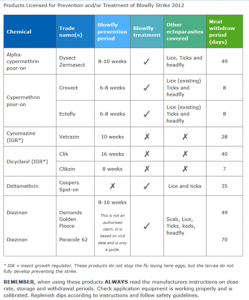 The insecticides recommended for the control of blowfly in the UK are Alpha-cypermethrin pour-on and Cypermethrin pour-on (both synthetic pyrethroids), the insect growth regulators (IGR) Cyromazine and Dicyclanil and the organophosphate OP Diazinon. The synthetic pyrethroid, Deltamethrin, is permitted for treatment only. The insect growth regulators are only used for control and not treatment; they are not suitable for established strike.
The insecticides recommended for the control of blowfly in the UK are Alpha-cypermethrin pour-on and Cypermethrin pour-on (both synthetic pyrethroids), the insect growth regulators (IGR) Cyromazine and Dicyclanil and the organophosphate OP Diazinon. The synthetic pyrethroid, Deltamethrin, is permitted for treatment only. The insect growth regulators are only used for control and not treatment; they are not suitable for established strike.
The most common approach to blowfly control is the prophylactic use of insecticide growth regulators (Bisdorff and Wall, 2008). These are not used for treatment as their mode of action is different. IGRs disrupt the larval moulting process by interfering with cuticle formation and chitin synthesis, so whilst eggs are still deposited and hatch, larvae continue to die as they reach their first moult for more than 12 weeks after treatment (Lonsdale et al., 2000; Wall and Lovatt, 2015).
The appropriate timing of treatment can have a major impact on the level of flystrike. Treating for strike later in the season, once blowfly numbers have already peaked makes the disease more difficult to control. Early season application, before the blowfly population can increase substantially in numbers, is particularly important. To maintain a low strike risk throughout the year, it may be necessary to treat twice, especially in a wet and humid year (from www.strikewise.com). A shorter acting product can be used on ewes before shearing, while a longer acting product can be used on lambs. Ewes are largely protected after shearing by shorter fleece length (Wall and Lovatt 2015).
Are you an organic farmer?
For organic farmers, organophosphate dips are not permitted. Where fly strike is a regular problem, insect growth regulators such as cyromazine and dicyclanil may be applied before the period of risk as part of an animal health plan on the basis of evidence of an actual risk, such as a veterinary declaration.
Organophosphate dips are toxic to humans. Repeated exposure to organophosphate-based pesticides cause changes in the nervous system and measures should be taken to reduce exposure to organophosphates as far as possible during agricultural operations (Murray et al., 1992; Stephens et al., 1995; Pilkington et al., 2001; Cherry et al., 2002; Povey, 2010). We do not encourage their use. Health and Safety procedures must always be followed.
There are concerns about the toxicity of synthetic pyrethroids and organophosphates to soil and aquatic vertebrates and invertebrates to the point where their use has been controlled in many countries. There is very little information regarding the ecotoxicity of the ‘insect’-growth regulators. These ecotoxicity issues are discussed by Beynon (2012).
Using fly traps
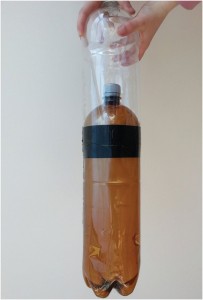 Fly traps can make an effective contribution to blowfly strike control on individual farms. However, to be economically viable they need to be efficient at attracting and killing flies large numbers of female flies over a sustained period of time. A variety of insecticide impregnated and baited traps have been tried but have been used mainly for monitoring (Broughan and Wall, 2006), with some success (e.g. Smith and Wall, 1998). Some traps, using synthetic bait, have been shown to be very effective against the Lucilia cuprina fly species commonly found in Australia, and are commercially available, although they are not effective against the Lucilia sericata species found in Europe (Hall et al., 2003).While rehydrated freeze-dried liver has been proposed as a convenient, easy-to-handle and an effective attractant (Broughan and Wall, 2006), there is still a requirement for a synthetically baited traps that could be easily used on farms. A home-made trap, using two 2-liter plastic drinks bottles, one clear and one brown, with offal as a bait (picture right), has been proposed by Wall and Lovatt (2015), but with no information about effectiveness.
Fly traps can make an effective contribution to blowfly strike control on individual farms. However, to be economically viable they need to be efficient at attracting and killing flies large numbers of female flies over a sustained period of time. A variety of insecticide impregnated and baited traps have been tried but have been used mainly for monitoring (Broughan and Wall, 2006), with some success (e.g. Smith and Wall, 1998). Some traps, using synthetic bait, have been shown to be very effective against the Lucilia cuprina fly species commonly found in Australia, and are commercially available, although they are not effective against the Lucilia sericata species found in Europe (Hall et al., 2003).While rehydrated freeze-dried liver has been proposed as a convenient, easy-to-handle and an effective attractant (Broughan and Wall, 2006), there is still a requirement for a synthetically baited traps that could be easily used on farms. A home-made trap, using two 2-liter plastic drinks bottles, one clear and one brown, with offal as a bait (picture right), has been proposed by Wall and Lovatt (2015), but with no information about effectiveness.


 British English
British English
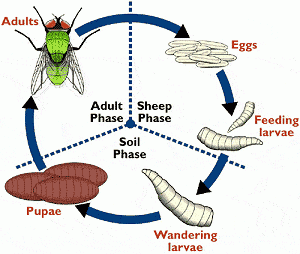
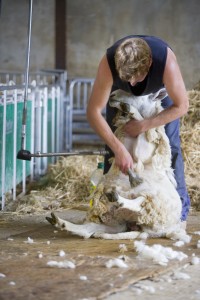

Comments are closed.